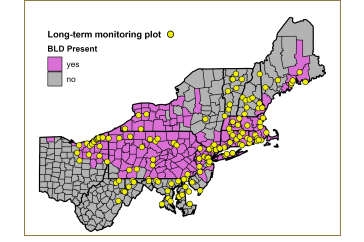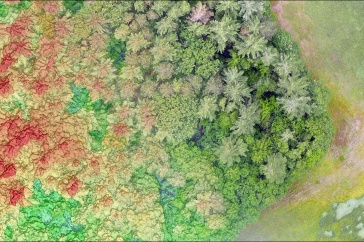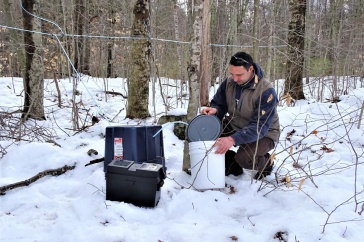Fungi from left to right, top then bottom row, Jackson's slender amanita (Amanita jacksonii), orange mycena (Mycena leaiana), shaggy scalycap (Pholiota sp.), golden trumpet (Xeromphalina campanella), Violet-toothed polypore (Trichaptum biforme), and a deer truffle (Elaphomyces verruculosus) with chew marks on it.
Key Finding:
Two of the most common ways that fungal spores are dispersed in a forest are by wind (via air currents) and by mammals (through scat); new research shows that these two methods complement each other. The fungi dispersed by each method differ in composition. For example, small mammals play important roles in dispersing mycorrhizal and soil saprotrophic fungi, whereas wind disperses more plant pathogens and wood and litter saprotrophic fungi. Additionally, mammal-dispersed spores often are larger in size.
Key Terms:
Agaricoid fungi: Expand for definition
Mushrooms belonging to the Agaricaceae family that are commonly distinguished by thin gills on the underside of the caps.
Arbuscular mycorrhizae (AM) and ectomycorrhizal (EcM) fungi: Expand for definition
Soil microorganisms that form mutual symbiotic relationships with plants, connecting the host plant to a mycorrhizal network that can improve access to nutrients and water. Around 90% of all plant species are associated with either AM or EcM fungi.
Corticioid (or crust) fungi: Expand for definition
Group of fungi that typically produce crust-like or patchy fruiting bodies, often found on dead trees and branches.
Forest disturbance: Expand for definition
Any number of different types of events that disturb a forest and allow for new plants, animals, and fungi to change the environment and landscape in the disturbed area.
Mushrooms: Expand for definition
Fungi that produce fruiting bodies aboveground.
Mycorrhiza: Expand for definition
Mycorrhiza means “fungal root” and refers to fungi with symbiotic relationships with plant roots.
Polypores: Expand for definition
Also called bracket or shelf fungi, polypores have a woody shelf-like or bracket-shaped appearance and generally form on tree trunks or branches.
Saprotroph/saprotrophic fungi: Expand for definition
The term saprotroph refers to organisms that feed on nonliving organic matter. Fungi are considered some of the most efficient saprotrophs in the natural world for their roles in decomposition and the recycling of nutrients back into the environment.
Truffles: Expand for definition
Fungi that produce fruiting bodies belowground.
The Fungi-Plant Connection:
It’s estimated that more than 90 percent of plant species maintain mycorrhizal relationships with fungal species. Fungi help extend plant root systems and explore the soil in search of additional nutrients for plants, described Station scientist Serita Frey, a professor in the department of natural resources and the environment.
“These fungi also confer other advantages to plants, including providing disease and drought resistance,” she added.
If you’ve been on a summer hike after a rain shower, you may have noticed a few more mushrooms than at other times. Mushrooms and many other less well-known types of fungi play key roles in forested ecosystems, helping transfer nutrients and water to plants and protecting roots from parasites found in the soil. In return, the fungi receive carbon-based food (sugars) from the plants. This synergistic relationship strengthens the health of the forest, which is especially important in New Hampshire, where nearly 80 percent of land is in forest coverage and annual output of the forest-products industry is valued at $1.4 billion. Sustainably managing forest land to ensure resilience of this special relationship depends on understanding how fungi enter forested areas that have been recently disturbed by natural or man-made events (particularly timber harvests)—a topic of continued study by NH Agricultural Experiment Station (NHAES) scientists.
Recently, an interdisciplinary team of researchers, including NHAES scientists Serita Frey and Rebecca Rowe, shared their findings into how wind and small mammals—eastern chipmunks, southern red-backed voles and woodland jumping mice—help disperse fungi. Fungi are typically dispersed by wind and by animals, the former by blowing air-borne spores to new locations and the latter by consuming fungal fruiting bodies (mushrooms, for example) and dispersing them to new areas through scat. In their research, published in the journal Ecology, the scientists studied whether wind disperses different fungi than mammals or if both mechanisms are generally similar.
Forest Regeneration Post Disturbance
“Natural and human-induced disturbance events are commonplace in forest systems, and successful forest regeneration is both economically and biologically critical,” said Benjamin Borgmann-Winter ’22G, lead investigator on the study and an NHAES-supported master’s student in the natural resources and the environment program in the College of Life Sciences and Agriculture at the University of New Hampshire. “Some fungal species persist in the soil after disturbance events, but many likely need to be imported back to disturbed areas as spores—so it’s important to study the mechanisms by which these fungi return because fungi directly affect the survival of trees, decomposition and nutrient cycling, and forest food webs.”
“When we understand how fungal communities recover from disturbance events, we better understand how forests themselves recover,” Borgmann-Winter added.
Wind Versus Small Mammals: How Fungal Spores Are Dispersed
A previous study by the team—led by NHAES-supported postdoctoral scientist Ryan Stephens ’18PhD—showed that small mammals serve as key dispersers of both arbuscular mycorrhizal and ectomycorrhizal fungi. However, fungi are dispersed in more than one way and the researchers wanted to compare small-mammal dispersal to wind dispersal, said Stephens.
“Our latest findings demonstrate that both methods—wind and small mammals—disperse very different fungal species, both taxonomically and in terms of the roles the fungi play in forest systems,” added Borgmann-Winter. “Small mammals are not merely dispersing the same species already dispersed by wind; they are in fact responsible for dispersing an almost entirely different subset of fungi.”
Left: From top: A southern red-backed vole (Myodes gapperi), woodland jumping mouse (Napaeozapus insignis) and an eastern chipmunk (Tamias striatus), all of which were studied for their roles as fungal dispersers.
Right: Proportion of reads per sample (mean ± standard error) for several common fungal functional types. Proportions were based on all present fungal amplicon sequence variants [ASVs] with known functional types. Within a panel, functional types with different letters are significantly different
In their most recent research, the team examined harvested timberland sites and adjacent undisturbed northern mixed wood and hardwood forests at Second College Grant in Coos County, New Hampshire. They measured the number of spores distributed by each of the three observed mammals and by wind through several methods, including small mammal live trapping and scat collection, aerial spore trapping conducted during peak mushroom fruiting periods, as well as microscopic and DNA analysis of the scat and airborne spore traps. They found that wind helped disperse aboveground fruiting fungi (mushrooms) found on trees (including polypores, corticioid or crust fungi) and in leaf litter, as well as dispersing plant pathogens, and that fungi dispersed by mammal scat typically consisted mainly of truffles and agaricoid (or gilled) mushrooms.
The study site—northern mixed wood and hardwood forests—located at the Second College Grant in Coos County, New Hampshire.
How Can This Information Support Forest Management Practices?
Wind- and mammal-facilitated dispersal of fungi complement one another and have important implications for the establishment and growth of new forest, with wind carrying in smaller spores and mammals generally dispersing larger spores. And it potentially means that forest regrowth and composition change with the presence of just one or the other method—and that without both methods, mixed hardwood forests of the Northeast could look very different.
“Following a timber harvest, it’s important to provide habitat for wildlife, such as small mammals, so they can continue to disperse spores of mycorrhizal fungi that are critical to tree survival and growth,” added Stephens. “This can be accomplished by creating cover within harvested areas in the form of downed wood or tops of trees along with small patches of vegetation.”
Next, the team plans to compare the soil fungal diversity, as well as the mycorrhizal colonization rate of plant feeder roots (the fine root hairs that grow from woody roots and are responsible for water and nutrient absorption), of two types of environments: fenced-off areas that mammals can’t access and unenclosed forest where mammals are already active.
“With this next study, our goal will be to better quantify the impact of mammal-dispersed fungal spores on plant and soil communities,” said Station scientist Rebecca Rowe, an associate professor in the natural resources and the environment department.
This material is based on work supported by the NH Agricultural Experiment Station through joint funding from the USDA National Institute of Food and Agriculture (under Hatch award number 1016133 and NIFA Fellowship award number 1019306) and the state of New Hampshire. Additional funding came from the UNH Graduate School, the Hamel Center for Undergraduate Research, and the Mycological Society of America’s Forest Fungal Ecology Postdoctoral Research Award.
This work is co-authored by Benjamin Borgmann-Winter ’22G, Ryan Stephens ’18PhD, Mark Anthony ’19PhD, Serita Frey, Anthony D’Amato and Rebecca Rowe.
You can read the published article, Wind and Small Mammals are Complementary Fungal Dispersers, in the Ecology.
-
Written By:
Nicholas Gosling '06 | COLSA/NH Agricultural Experiment Station | nicholas.gosling@unh.edu

























































